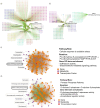Diurnal rhythms in durum wheat triggered by Rhopalosiphum padi (bird cherry-oat aphid)
- PMID: 40211135
- PMCID: PMC11984048
- DOI: 10.1186/s12870-025-06100-0
Diurnal rhythms in durum wheat triggered by Rhopalosiphum padi (bird cherry-oat aphid)
Abstract
Wheat is a staple crop and one of the most widely consumed grains globally. Wheat yields can experience significant losses due to the damaging effects of herbivore infestation. However, little is known about the effect aphids have on the natural diurnal rhythms in plants. Our time-series transcriptomics and metabolomics study reveals intriguing molecular changes occurring in plant diurnal rhythmicity upon aphid infestation. Under control conditions, 15,366 out of the 66,559 genes in the tetraploid wheat cultivar Svevo, representing approximately 25% of the transcriptome, exhibited diurnal rhythmicity. Upon aphid infestation, 5,682 genes lost their rhythmicity, while 5,203 genes began to exhibit diurnal rhythmicity. The aphid-induced rhythmic genes were enriched in GO terms associated with plant defense, such as protein phosphorylation and cellular response to ABA and were enriched with motifs of the WRKY transcription factor families. In contrast, the genes that lost rhythmicity due to aphid infestation were enriched with motifs of the TCP and ERF transcription factor families. While the core circadian clock genes maintain their rhythmicity during infestation, we observed that approximately 60% of rhythmic genes experience disruptions in their rhythms during aphid infestation. These changes can influence both the plant's growth and development processes as well as defense responses. Furthermore, analysis of rhythmic metabolite composition revealed that several monoterpenoids gained rhythmic activity under infestation, while saccharides retained their rhythmic patterns. Our findings highlight the ability of insect infestation to disrupt the natural diurnal cycles in plants, expanding our knowledge of the complex interactions between plants and insects.
Keywords: Rhopalosiphum padi; Aphid; Diurnal; Rhythmicity; Transcription factor; Transcriptomics; Untargeted metabolomics; WRKY; Wheat.
© 2025. The Author(s).
Conflict of interest statement
Declarations. Ethics approval and consent to participate: Not applicable. Consent for publication: Not applicable. Competing interests: The authors declare no competing interests.
Figures







Similar articles
-
Comparative transcriptomic and metabolic analysis of wild and domesticated wheat genotypes reveals differences in chemical and physical defense responses against aphids.BMC Plant Biol. 2020 Jan 13;20(1):19. doi: 10.1186/s12870-019-2214-z. BMC Plant Biol. 2020. PMID: 31931716 Free PMC article.
-
Cereal aphids differently affect benzoxazinoid levels in durum wheat.PLoS One. 2018 Dec 3;13(12):e0208103. doi: 10.1371/journal.pone.0208103. eCollection 2018. PLoS One. 2018. PMID: 30507950 Free PMC article.
-
Silicon-induced changes in plant volatiles reduce attractiveness of wheat to the bird cherry-oat aphid Rhopalosiphum padi and attract the parasitoid Lysiphlebus testaceipes.PLoS One. 2020 Apr 3;15(4):e0231005. doi: 10.1371/journal.pone.0231005. eCollection 2020. PLoS One. 2020. PMID: 32243466 Free PMC article.
-
Diurnal feeding as a potential mechanism of osmoregulation in aphids.Insect Sci. 2021 Apr;28(2):521-532. doi: 10.1111/1744-7917.12787. Epub 2020 Jun 25. Insect Sci. 2021. PMID: 32240579
-
Exploring the metabolic variation between domesticated and wild tetraploid wheat genotypes in response to corn leaf aphid infestation.Plant Signal Behav. 2018;13(6):e1486148. doi: 10.1080/15592324.2018.1486148. Epub 2018 Jun 26. Plant Signal Behav. 2018. PMID: 29944455 Free PMC article.
References
-
- Nozue K, Maloof JN. Diurnal regulation of plant growth. Plant Cell Environ. 2006;29. - PubMed
-
- Erenstein O, Jaleta M, Mottaleb KA, Sonder K, Donovan J, Braun H-J. Global trends in Wheat Production, Consumption and Trade. In: Reynolds MP, Braun H-J, editors. Wheat improvement: Food Security in a changing climate. Cham: Springer International Publishing; 2022. pp. 47–66.
MeSH terms
Grants and funding
LinkOut - more resources
Full Text Sources

